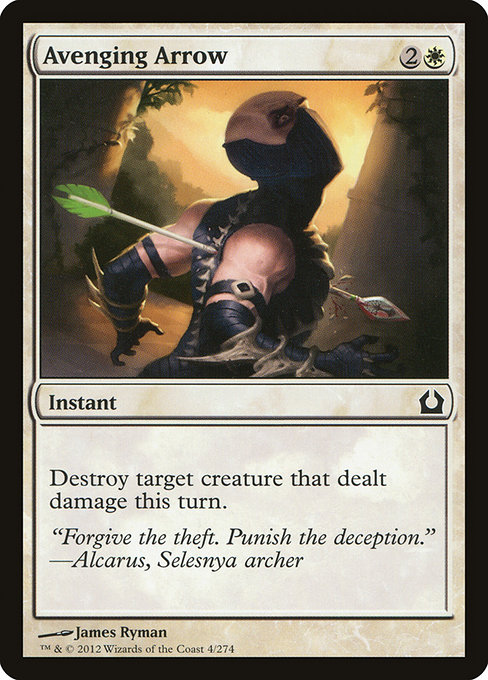
Image courtesy of Scryfall.com
Legends connected to Avenging Arrow’s ability
White removal has always worn a mask of elegance—clean lines, clean outcomes, and just a touch of moral arithmetic. Avenging Arrow, a humble common from Return to Ravnica, embodies that ethos with a precise question: if a creature has already dealt damage this turn, should it still be on the battlefield? The answer, in MTG terms, is often a hard “no.” This instant for {2}{W} destroys a creature that dealt damage this turn, a constraint that nudges players toward both timing and respect for the legends that populate the board. 🧙♂️🔥
The card in context: Return to Ravnica’s white tempo
Avenging Arrow sits in white’s wheelhouse as an efficient, targeted answer to aggression. For a modest mana investment, you remove a threat after it has already made its impact—whether that threat came through a brutal alpha strike in combat or a surprise damage from a creature with an ability. The flavor text—"Forgive the theft. Punish the deception." —Alcarus, Selesnya archer—reads like a guild oath translated into game mechanics: a commitment to swiftly end deceitful or reckless threats while upholding a sense of order. The art by James Ryman captures a moment of righteous consequence that fans memorably associate with white’s defensive posture. 🎨⚔️
Legendary interactions: when “dealt damage this turn” matters
What makes Avenging Arrow particularly interesting in the long arc of MTG history is its interaction with legendary creatures—the storied figures that have defined formats and formats’ lore for decades. Because the spell cares about the event “dealt damage this turn,” it can exile a legendary creature that just swung in for a big hit. In other words, it punishes aggression not by ignoring the afterglow of combat, but by catching the culprit in the act and removing it before it can enact more mischief later in the turn. 🧙♂️💎
- Combat-heavy commanders and legendary attackers in casual and multiplayer formats—imagine a legendary dragon or a mighty angel that just dealt combat damage. Avenging Arrow can answer back by destroying that threat if it’s the same turn. This is classic white tempo: you don’t need to overcommit to removal; you simply answer when the dust settles. ⚔️
- Legendary creatures with built-in damage output—think of powerful, story-rich staples that often carry the battlefield pressure. The arrow’s clause makes timing everything; if you wait a turn, the window closes, but if you react mid-turn, you deny a key payoff. 🔥
- Across formats—Modern, Legacy, and Commander—the spell’s constraints remain relevant. It’s a neat puzzle piece in decks that want a clean answer to big, legendary threats without overextending into resource-heavy removal suites. 🧩
“Destroy target creature that dealt damage this turn.” A line that feels small, but in practice can swing games when a legendary behemoth threatens to snowball a meetup. The utility isn’t about removing every big threat; it’s about keeping the board honest and giving you a lifeline in tight late-game spots.
Design notes: a tiny, elegant trick with big implications
Avenging Arrow embodies a design space that white has navigated beautifully: a low-cost instant that punishes violence with surgical precision. The “dealt damage this turn” clause means you can’t save it for a creature that’s just sitting there after taking no damage; you must time it with the moment of impact. This creates memorable plays and a handful of tricky decisions—especially when facing legendary threats that can alter the tempo of a game with a single swing. The common rarity belies its importance in a metagame where tempo and efficiency often decide wins and losses. 🧙♂️⚖️
Flavor, lore, and the arc of white removal
The Return to Ravnica block brought a multicolor tapestry to MTG, where Selesnya’s communal calm meets white’s disciplined discipline. In that spirit, Avenging Arrow can be seen as a vigilante’s snap judgment—a swift correction to deception, aligning perfectly with the flavor of a guild that values harmony but will not tolerate treachery. The card’s title and flavor text echo a broader theme in MTG: the idea that justice, even when administered with a precise blade, must be served promptly and fairly. For collectors and lore fans alike, this instant provides a small but satisfying bridge between story and gameplay. 🧭🎲
Practical play: when to cast Avenging Arrow
- Turn two or three tempo plays: you’re under pressure, you can spend two mana plus a white to erase the biggest immediate threat that dealt damage this turn. 🔎
- In creature-light matchups: a low-cost answer to a single dangerous attacker can stabilize the battlefield and buy you turns to develop resources. 💪
- In commander games: it’s easy to fit into a curve without overcommitting to removal, while still offering a strong reply to the most threatening legendary attackers. 👑
Art, rarity, and market texture
As a common from a two-color, guild-centered set, Avenging Arrow offered players a reliable option long before widespread, flashier removal became the norm. Its low price point — historically hovering around a few dimes in non-foil form — makes it an accessible pick-up for budget builds and experimental decks alike. For foil enthusiasts, the card’s foil variant adds a glint to the white removal story, a reminder that even small spells can carry big personalities on the battlefield. The card’s enduring presence in formats where it’s legal speaks to the timeless appeal of precise, well-timed answers. 🧊💎
Lore-anchored takeaway for fans
In MTG’s grand tapestry, the legends aren’t just about towering creatures or epic spells; they’re about moments—timed plays, moral choices, and the quiet satisfaction of punishing overreach. Avenging Arrow captures that ethos with a clean, memorable mechanic and a flavorful lineage tied to Return to Ravnica’s Selesnya ethos. It’s a reminder that sometimes the most legendary action is not the biggest explosion, but the precise, well-placed strike that preserves balance and keeps the multiverse turning. 🎨🧙♂️